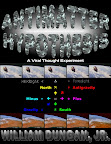Astrophysicists claim that the universe is predominantly composed of matter. Logic dictates that this is incorrect. Matter and antimatter should exist in equal amounts. So should we believe the experts? They could be right, but could they be wrong? Maybe they know something that we don’t know, or maybe they took a wrong turn someplace? The flat Earth experts were wrong by modern standards, but could modern day experts be wrong about modern standards? One of the telltale signs of truth is consistency, and consistency has two components: consistency of thought, and consistency between thought and reality. One way to preserve consistency is to remain skeptical about inconsistencies. In the extreme we call this consistency of thought prejudice. Consistency between thought and reality often demands new models that incorporate anomalies inconsistent with conventional theories. Developing new models is not an easy task. Science is the realm of making models consistent with reality. Another perceived sign of truth, other than consistency, is symmetry.
By symmetry matter and antimatter should be equal and opposite, but with an equal amount of matter and antimatter in the universe, where is all the antimatter lurking? Observations indicate that our galaxy is composed of matter. Close encounters with stray antimatter are rare. The way light interacts at the atomic level, photons do not discriminate between matter and antimatter. All the galaxies seen through telescopes could be all matter or all antimatter or both. If galaxies are composed of both matter and antimatter, then annihilations must be happening all the time. In fact a background of gamma ray bursts has been detected, which is consistent with particle antiparticle annihilations. But a galaxy harboring matter and antimatter resembles a pinball machine, not the clockwork mechanism that astronomers observe.
Black Holes
For the most part, matter and antimatter must be segregated. Where’s the safest place to isolate antimatter in our galaxy? Astronomers have detected evidence of black holes at the center of galaxies including our own galaxy, the Milky Way. If the black hole at the center of our galaxy is made of matter, then all the matter swirling about our galaxy is in a death spiral. But what if the black hole at the core of our galaxy is composed of antimatter? What’s the opposite of death? Death is the end of life. What do we call the beginning of life? Birth.If black holes at the core of galaxies are not death spirals, but birth spirals, then the Big Bang is in big trouble. As children we were led to believe that a central factory someplace makes babies who are delivered by storks to mommies and daddies. Eventually we all learn better. The Big Bang creation myth expects us to believe that everything in the universe was created by spontaneous generation during a one time event at a central factory someplace, but was it? Was creation a one time event, or is creation an ongoing local process. The electric charge of electrons and positrons attract each other and they annihilate, but what about neutrons? Neutrons and antineutrons have zero electric charge, so no electrostatic force applies. What about gravitational forces?
Astrophysicists make the claim that nothing can escape a black hole, not even light. The event horizon of a black hole is the point of no return, where escape velocity equals the speed of light, and nothing can exceed the speed of light. However, the evaporation of black holes has been proposed by way of Hawking radiation, a scenario in which a particle-antiparticle pair is produced from energy just outside the event horizon. One of the pair falls into the black hole, while the other escapes. Since mass and energy are equivalent, any emitted mass subtracts from the black hole and in essence the black hole evaporates. How fast and under what conditions black holes evaporate are open questions.
However, consider what would happen if a neutron antineutron pair form inside the Schwarzschild radius of an antimatter black hole. If astrophysicists are correct, then nothing can escape a black hole. If antigravity is real and acts according to expectations, then conventional explanations are wrong. An antimatter black hole would attract the antineutron into a death spiral, but repel the neutron.
| Gravitational Axis | ||
| ↑ | 0 | ↓ |
| Antimatter Black Hole → n° → n° → n° → n° → n° → n° → Neutrons → Hydrogen | ||
| ∞ | ||
| Antihydrogen ← Antineutrons ← n° ← n° ← n° ← n° ← n° ← n° ← Matter Black Hole | ||
| Recycling Universe | ||
An antimatter black hole would expel neutrons, and the obverse is also true. A matter black hole would expel antineutrons, in which case black holes supply the material for galaxy formation. Black holes give birth to galaxies, and creation is not unique to the universe as a whole, but ubiquitous to local galaxies. Furthermore, the birth of a galaxy results in the eventual death of the parent black hole at its core through evaporation.









No comments:
Post a Comment